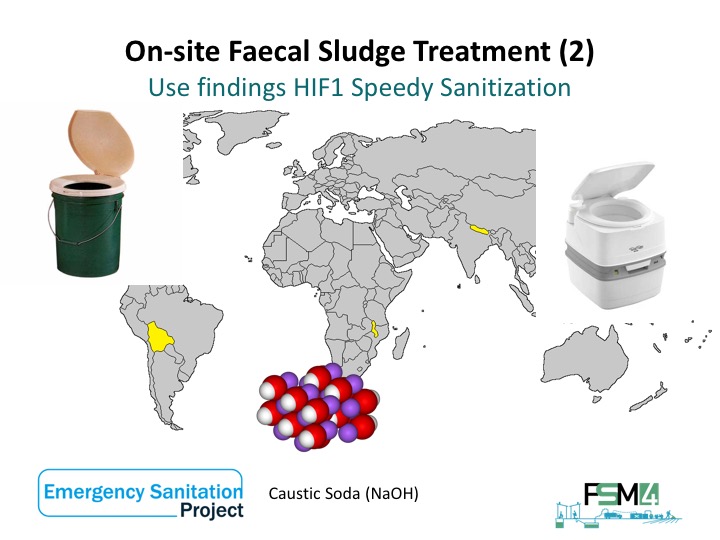Through funding from the Humanitarian Innovation Fund (HIF), this research was initiated to determine whether commercially available additives can stabilize and sanitize faecal sludge. The main objective was to identify select/develop and test effective bio/chemical additives that convert faecal matter into a harmless and non-smelling product. In order to achieve the main objective the following specific objectives were followed:
- Determine a set of requirements that the additives to be selected need to fulfil.
- To obtain a comprehensive overview of existing bio-additives and select the most promising.
- To develop a protocol that can be used to assess the effectiveness of bio-additives.
- To test the selected bio-additives on real faecal matter.
- To assess whether the bio-additives tested are working satisfactorily and to decide whether it is worthwhile to develop prototypes.

This study characterized black water and faecal sludge from four countries; Netherlands, Malawi, Bolivia and Nepal, and determined the efficacy of 5 additives at lab scale and 13 additives in the field to rapidly stabilize and sanitize faecal sludge with the aim of applying it in emergencies. 3 field trials were run in Malawi, Bolivia and Nepal applying different dosages. The stability was evaluated against attaining volatile solids reduction (VSR) whereas the sanitization was evaluated against WHO guideline value for restricted irrigation.
From this study, the following conclusions can be drawn:
- Rapid stabilisation and sanitisation of faecal sludge is most likely to be achieved using chemical additives as indicated by Ikati, Soda, Urea and Lime.
- Bio-additives did not increase the rate of stabilisation and sanitisation for the treatment period studied as was found by previous studies with other additives (Buckley et al., 2008; Foxon et al., 2008), however a locally produced EM (effective microorganism) in Nepal was capable to stabilize the faecal sludge between two weeks, additionally the mixing or no mixing condition does not have an effect on its performance.
- Significant reduction in concentrations of E. coli was observed in FS treated with additives of chemical origin – Ikati, Soda, Lime and Urea.
- There is no significant difference in faecal sludge treated with Ikati, Soda, Lime and Urea with the rest of the additives and controls in terms of pathogen reduction. The choice between them should be based on other factors such as treatment period and costs.
- The die-off of faecal coliform in black water/ faecal sludge treated using Ikati and Soda was likely caused by the carbonate ion. The dosages should be increased if a shorter treatment time is desired (Arthurs et al., 2001; Diez-Gonzalez et al., 2000; Jarvis et al., 2001; Park and Diez-Gonzalez, 2003).
- From the biological additives tested only EM locally produced in Nepal performed successfully stabilizing the faecal sludge and reducing significantly the pathogen concentration (although not below the WHO recommended limit). It indicates that biological additives may be effective when they are working under the climate conditions where they are produced. For emergencies biological additives may not be very effective unless they are produced in the place where the emergency happened.
- As it was already identified in previous studies done by WASTE the mixing condition using chemical additives like Lime, Soda and Urea has a significant influence in the performance. Especially when applying the additives at large volumes of faecal sludge (>100L) it is very important to mix properly to assure the effect of sanitization and stabilization of faecal matter.
- At small scale (simulating bucket toilet) the mixing also is very important, however to mix low volume of faecal sludge is easier than large volumes.
- In order to continue with the second phase of this research, it is recommended to design a device to mix and add the recommended dosages of effective additives, putting more attention in the mixing conditions for large volumes of faecal sludge.
The final report can be downloaded here. The annexes are:
APPENDIX_1_Final Report on Soda_Dosage
APPENDIX_2_Final Report on Lime_Dosage
APPENDIX_3_Final Report on Field_Parameters
MORE INFORMATION?
If you have any questions please get in touch with:
Jan Spit, Adviser Sanitation
WASTE advisers on urban environment and development
www.waste.nl
e-mail: jspit@waste.nl
mob: +31 6 57 99 78 74